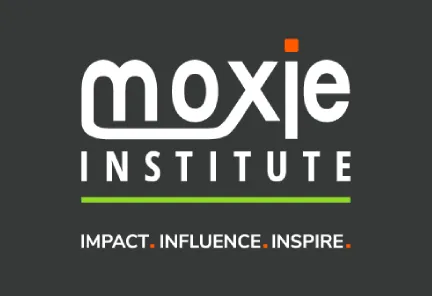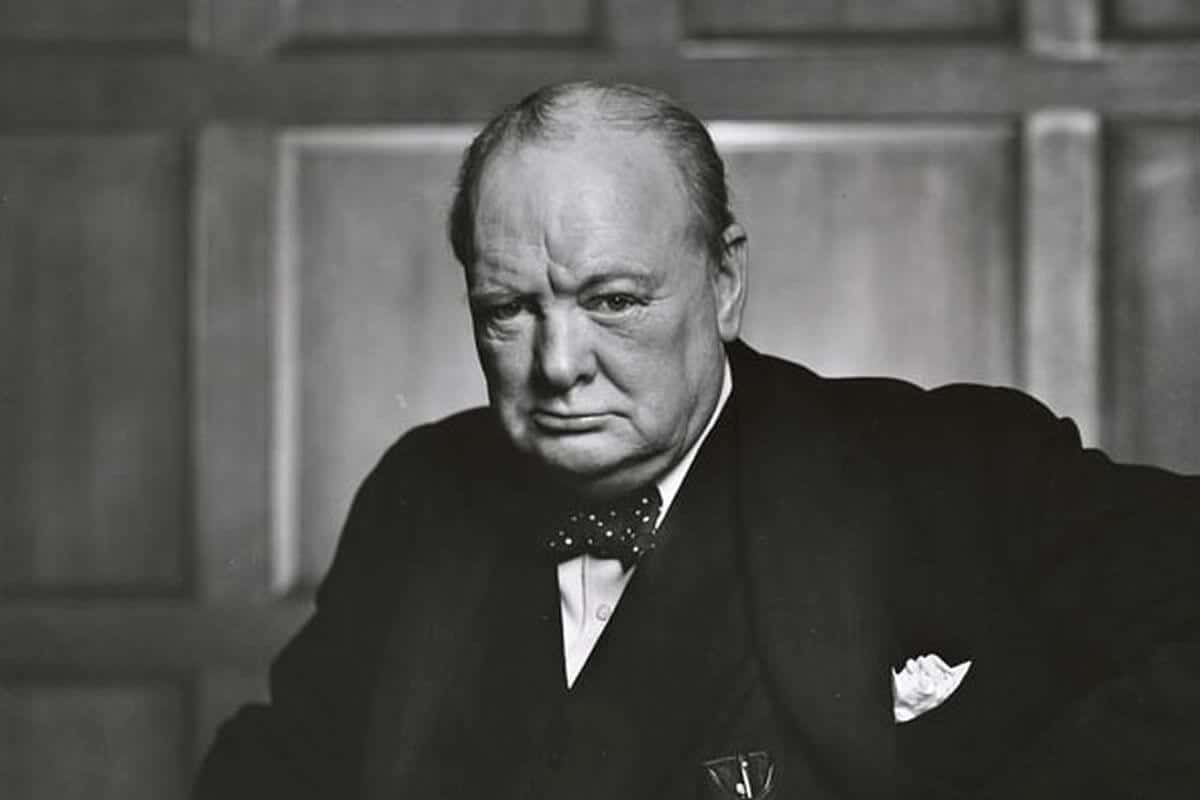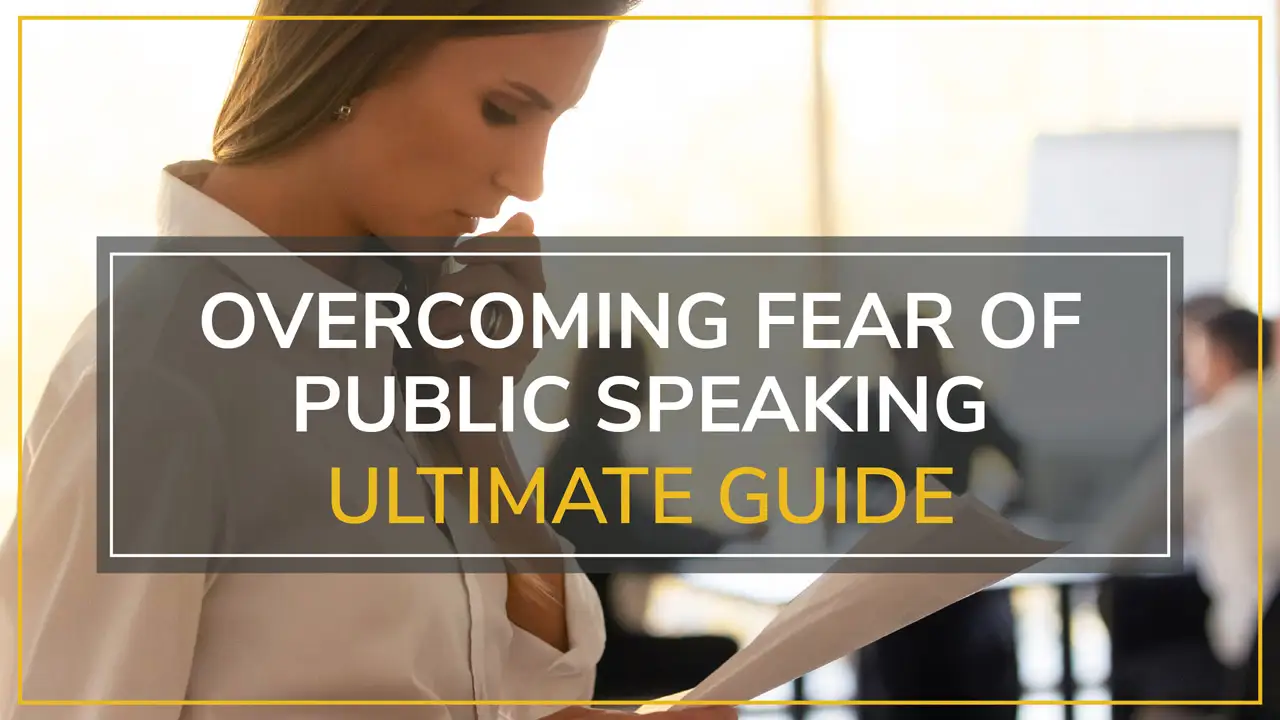Introduction
Did you know one of the greatest orators in history used to shake at the idea of public speaking? Winston Churchill, who used his stirring wartime addresses to stiffen the spine of a nation in the bleakest days, was a charlatan when it came to mastering his own fear of public speaking – a fear millions share even more keenly today. But this man, who would one day speak his way into history, found ways to turn his debilitating glossophobia into one of his greatest assets.
In our professional life coaching execs and professionals across industries, we’ve learned that many of our clients are consoled to know that they’re not alone experiencing fears that even legendary communicators like Churchill, faced every time they needed to stand and speak. Public-speaking terror – also known as glossophobia – is believed to affect as much as 75% of the population, making it one of the most prevalent phobias. How Churchill accomplished this feat is a valuable lesson for today’s professionals trying to conquer their own fear of public speaking.
At Moxie Institute, we’ve coached thousands of professionals in converting their fear into confidence by adopting our neuroscience-based training for public speaking. Churchill’s experience is a fascinating historical example of what we now know about overcoming glossophobia. From his agonizing parliamentary hesitations to his immortal “We shall fight on the beaches” speech, Churchill’s transformation offers timeless lessons for overcoming the fear of public speaking.
In this ultimate guide we’ll look at Churchill’s battle with stage fright and the solutions he came up with, to find out how these same insights – now reinforced by modern science and performance psychology – will help you crush your fear of public speaking.
The Surprising Truth About Churchill's Early Speaking Career
Winston Churchill may have been one of history’s greatest orators, but here’s a secret: He wasn’t born that way. In reality, his early professional life was filled with anxiety, self-doubt and even embarrassing performances — experiences that many professionals today are likely to find all too relatable.
Churchill’s First Parliamentary Speech: A Nerve-Wracking Experience
Winston Churchill, the 26-year-old guest, was shivering with nerves on February 18, 1901, when he rose to give his maiden speech in the House of Commons. Though the latter had been preparing diligently, he was pale and uncertain when described in contemporary reports. Churchill would later write that he had felt a “sensation of panic and fear” that had “swept behind his judgement” as he moved to speak to his fellow Members.
Churchill had known for months that this moment would be upon him, but on the day he found himself beset by what we now identify as textbook glossophobia, and he needed some Belushi-level psychic fasting to revive himself. He had worked for hours to learn and the speech, he had practiced it countless times, and yet he was terrified as he stood before his audience.
What’s especially noteworthy is the way Churchill described this as a letter to his mother: “I went through all the sensations of the condemned;” This poignant message is a testament to the degree of public speaking fear that even this future master communicator felt.
The Physical Symptoms Churchill Endured
As is not uncommon with many professionals today, Churchill suffered from speech anxiety, which manifested itself through body language:
- Voice tremors: Early recordings reveal a slight tremor in his voice during speeches
- Excessive perspiration: Churchill often brought extra handkerchiefs for speeches
- Memory lapses: He sometimes froze momentarily, forgetting his prepared remarks
- Rapid heartbeat and shortness of breath: These symptoms plagued his early speaking engagements
The Churchill Centre’s Professor Richard Langworth observes, had ways of dealing with these physical symptoms of stress. That could mean, for example, holding the podium both to keep his hands from shaking, pausing at key moments to regulate his breath and keeping notes at such a point that he wouldn’t forget what to say.
“The physical manifestations of speech anxiety Churchill wrote about are uncannily similar to what we witness with executive clients now. The difference is that Churchill discovered systematic techniques for not only controlling these symptoms but converting them into elements of his own forceful delivery.” -When we coach Fortune 500 executives at Moxie Institute
Key Insights:
- Even great speakers, such as Churchill had huge fear of public speaking to begin with.
- Symptoms of physical glossophobia have not changed through the yearsournes There are also physical symptoms that come along with the fear of public speaking.
- Churchill’s example shows that public speaking anxiety can be mastered with the right techniques.
- In public speaking, success is made, not born – an important message for professionals today
How Common is Glossophobia? Understanding the Science
Churchill wasn’t the only individual gripped by fear. Glossophobia (fear of public speaking) is typically reported as the top-ranking phobia (above even that of dying or of a fear of heights or of drowning).
The Neuroscience Behind Speaking Anxiety
Modern neuroscience explains what Churchill could only have intuited: public speaking is so terrifying because the speaker has much to lose should he or she fail in their bid to impress. The amygdala — the threat center of our brain — can kick into high gear as though we were confronted with a physical threat, not merely attentive listeners.
According to study in The Science Direct, fear of public speaking induces the secretion of stress hormones such as cortisol and adrenaline, resulting in the ‘fight or flight response’. These hormones can produce physical symptoms which are:
- Increased heart rate and blood pressure
- Shallow breathing
- Muscle tension
- Excessive sweating
- Dry mouth
- Cognitive impairment (the dreaded “mind going blank”)
This reaction comes from an evolutionary paradox, neuroscientist Dr. Andrew Huberman of Stanford University says, in that humans are social animals, but for much of our history, being the center of attention has meant being at risk. This is why even experienced professionals may feel nervous before presentations.
As a 2019 study published in the Journal of Applied Psychology noted, anxiety about public speaking activates the same set of brain structures associated with physical pain, which could be why the prospect of giving a speech feels viscerally threatening.
Why Even Accomplished Professionals Fear Public Speaking
Statistics reveal the prevalence of this fear among even high-achieving individuals:
- According to the National Institute of Mental Health, approximately 73% of the population experiences some degree of glossophobia
- A 2018 survey by the Association for Talent Development found that 80% of executives report anxiety before important presentations
- Gallup research indicates that public speaking anxiety costs businesses billions annually in lost productivity and missed opportunities
Churchill’s case is also noteworthy because, by the time he entered politics, he was already experienced and capable in so many other fields. He was a bestselling author, a military veteran and an internationally recognized figure — and he was still struggling with extreme stage fright.
This trend is reflective of what we see in our executive clients now. In our coaching work at Moxie Institute, we are often hired by extraordinarily successful C-suite executives who are rock stars within their technical expertise, but they still suffer from debilitating anxiety when they need to deliver presentations to boards, investors, or even large audiences.
“The most powerful finding from contemporary neuroscience is that speaking anxiety is not a characterological defect or a weakness — it’s a natural neurological response that can be systematically reconditioned with appropriate training.” – By incorporating what we’ve found through working with thousands of professionals at Moxie Institute
Quick Takeaways on Glossophobia:
- Public speaking anxiety affects approximately 75% of the population, including high achievers
- The fear has a neurobiological basis that triggers physical and cognitive symptoms
- Modern neuroscience confirms that speaking anxiety is a natural response, not a personal failing
- Even historically great speakers like Churchill had to overcome this common fear
Churchill's 5 Strategies for Overcoming Stage Fright
Churchill didn’t merely endure his speaking anxiety—he systematically conquered it through methods that align remarkably well with today’s evidence-based approaches. Let’s examine the five key strategies he employed:
1. Meticulous Preparation and Practice
Churchill’s concept of preparation was the stuff of legend. He’s one for whom at critical speeches, his personal secretary told me that he would spend roughly an hour in preparation for every minute that he would deliver. His determination translated his fear into confidence.
Key elements of Churchill’s preparation included:
- Research immersion: Churchill would gather extensive background information, statistics, and historical context
- Deliberate practice: He rehearsed aloud, often in front of mirrors or trusted advisors
- Spaced repetition: Rather than cramming, he spread his practice over multiple days
- Environmental simulation: When possible, he would practice in the actual venue
Churchill described the moment in his memoir “My Early Life,” writing: “I had worked long and hard for the speech, and had been over it, on it and through it from all points of view for weeks prior to its delivery. ”I had thought over and practised it in every mood and all kinds of tone.” This preparedness helped to mitigate the effects of anxiety on cognition during birth.
Pro Tip: Neuroscientists today know that Churchill’s approach was better. Spaced practice (breaking up rehearsals over time) is much more effective than massed practice (cramming) in developing confident delivery, according to research. At Moxie Institute, we suggest using the “3-3-3” approach: practice three times, three days apart, and three different ways (e.g., focusing first on content, then on delivery, and then on anticipating questions).
2. Memorization and Visualization Techniques
Churchill could not have known about 21st century performance psychology—but he had an innate ability to practice visualization, which we now know from neuroscience is one of the most powerful tools we have:
- Mental rehearsal: Churchill would mentally walk through his entire speech, visualizing success
- Strategic memorization: Rather than memorizing word-for-word, he focused on key points and transitions
- Linguistic anchoring: He created memorable phrases to serve as mental anchors throughout the speech
Churchill’s physician, Lord Moran, recorded that before important speeches he would frequently sit in silence with his eyes closed, moving his lips slightly — a form of visualization and mental rehearsal, as we now know.
It turns out that visualizing moves burns a significant number of the same neural pathways as when you do the thing for real, so you may just get stronger while you sit on your couch.
3. Strategic Use of Notes and Structure
Churchill devised a unique method of note-taking that gave him security without becoming a crutch:
- The “brick” format: He arranged notes on small, staggered pages resembling brick layouts
- Typography emphasis: Key words were underlined or capitalized for emphasis
- Phonetic spelling: Difficult words were written phonetically to ensure proper pronunciation
- Pause notation: He marked natural breathing and emphasis points
These prepared notes were a safety net, easing worries of the moment while ensuring a better message. Crucially, it was not as though Churchill was doing this under cover — he knew that listeners did not expect polished memorisation but only self-assured delivery.
Churchill’s speech notes are preserved in the Churchill Archives at Cambridge University and show just how detailed his structuring process was. All of them were nicely structured with an attention grabbing introduction, linear flow, a strong close – which gives the confident of clarity.
4. Voice and Delivery Mastery
Most famously, perhaps, Churchill worked methodically to overcome a very slight speech impediment and mold his unmistakable vocal intonations:
- Breathing exercises: He practiced diaphragmatic breathing to support voice projection
- Articulation drills: Churchill used tongue twisters and articulation exercises
- Strategic pausing: He mastered the dramatic pause, turning potential hesitation into powerful emphasis
- Rhythm variation: He consciously varied his pace to maintain audience engagement
Churchill supposedly trained himself to speak with pebbles in his mouth (a la the ancient Greek orator Demosthenes) to help remedy that articulation problem. Although we actually no longer advise this exact method, the principle of specific vocal training is still a fundamental need.
Through analyzing Churchill’s speeches, voice coach Elizabeth Stanton has identified his conscious use of what is now known as “prosodic features” – variations in pitch, volume and tempo that elicit emotional involvement. These were tools to convert his natural fear of speaking into charismatic presentation.
5. Embracing Authenticity and Emotional Connection
One of Churchill’s most illuminating insights was that becoming perfectly polished was not as important as real connection:
- Emotional investment: He connected personally with his material
- Conversational approach: Despite formal settings, he aimed for conversational authenticity
- Strategic vulnerability: Churchill occasionally acknowledged challenges, creating audience connection
- Value-driven content: He focused on meaningful messages rather than perfect delivery
In a revealing note to a fledgling politician asking for guidance on public speaking, Churchill penned:“When the eagles are silent, the parrots begin to jabber.” It encapsulates his approach of valuing substance and genuine belief over a polished delivery — which, ironically, is one of the best ways to combat the fear of public speaking, because it takes the attention away from self and refocuses the message.
Key Takeaways from Churchill’s Strategies:
Churchill had prepared for the moment, successfully combating his anxieties with thorough preparation.
- Organization confers safety: Organization that reduces cognitive effort while speaking.
- Confidence grew with increasing physical control: From the way she made her vocal and breathing techniques turn nervous energy.
- Authenticity is greater than perfection: Concentration on the message instead of the perfect execution overcame the anxiety to perform correctly
It’s important for those who want to improve their public speaking training or to beat their fears of speaking. As Churchill knew, though, these tactics can turn the most nervous speaker into an effective one.
Common Obstacles in Overcoming Public Speaking Fear

Though Churchill eventually became a master orator, his path was not without stumbles. A look at the hindrances he had to overcome is instructive in terms of the common issues many professionals struggle to overcome while solving their glossophobia problem.
Perfectionism: The Enemy of Progress
In his early career, Churchill was crippled by the debilitating curse of perfectionism that fueled his speaking anxiety. Legend has it that in the beginning he used to place impossible pressure on himself, and the self imposed burden was not allowing him to play freely.
This perfectionism was reflected is this what you were trying to say? in the way he: (as quoted in Manchester, “The Last Lion, Vol. III”) Writer William Manchester wrote that his perfectionism was made manifest in:
- Excessive self-criticism after speeches
- Obsessive rewriting that sometimes diluted his authentic voice
- Painful rumination over minor errors
- Comparing himself unfavorably to more experienced speakers
Churchill slowly came to understand that this perfectionism was self-defeating. In a revealing comment to his wife, Clementine, after a speech in parliament, he wrote: “I shall never be content with any speech, but perhaps that is not wholly a bad thing.”
This observation squares neatly with what we now know from cognitive psychology: perfectionism actually exacerbates public speaking anxiety, imposing unrealistic criteria and raising self-awareness. Science published in Journal of Anxiety Disorders, found that “perfectionistic strivings is one of the strongest predictors of PSAs.”
How to Overcome Perfectionism:
- Aim for excellence rather than perfection
- Focus on audience impact rather than flawless delivery
- Practice self-compassion when reviewing performances
- Recognize that authentic connection matters more than technical perfection
Catastrophizing: When Your Mind Creates Worst-Case Scenarios
One or two books on Churchill, wrote a historian whose work I fail to remember, seemed to dangle key events in history from the coat racks of Churchill’s career imagining, that is to say, that had he not acted as he did the world would be a different if not vastly worse place. 1 This doctrine of what psychologists today call “catastrophizing” surfaced very early in his career. This amplification of anxiety represented a cognitive distortion.
4 In letters to friends, the young ChurchillConfided that he dreaded that:Pessimistic note in common With him and his family When he reached fifty Churchill used to say: My Grandpapa at the age of fifty.
- His mind would go completely blank
- The audience would be openly hostile or mocking
- His career would be irreparably damaged by a poor performance
- His speech impediment would make him unintelligible
These fears were understandable but greatly overstated relative to the low risk. Catastrophizing is considered to be a central component to speaking anxiety in the context of contemporary cognitive-behavioral theory, and is thought to lead to a repetitive cycle by which anticipatory anxiety itself raises the risk for performance problems.
How to Combat Catastrophizing:
- Challenge and Eliminate Over-Exaggerated Negative Thoughts.
- Explore past examples of evidence that disputes worst-case fears
- Create the more balanced overview of what all might happen.
- Prepare for how you will deal with obstacles if they do occur.
Audience Misperception: The Reality Gap
One of Churchill’s most important insights — he inscribed it in private notes — was about the distance between how speakers think audiences receive their words and how they actually absorb them. In his early years, he saw the audience as critical assessors, not participants.
This shift in perception is consistent with what these researchers have found in work on the “spotlight effect” in social psychology: that we tend to overestimate how much people observe our jitters or flubs. A seminal study in the Journal of Personality and Social Psychology discovered that speakers overestimated by 25 to 40 percent the extent to which their nervousness was apparent to an audience.
Churchill slowly learned what we currently teach openly: audiences actually want speakers to do well, they notice way fewer “mistakes” than the speaker assumes, and the value of the speech is mostly about the value of the content versus the finesse of the delivery.
Strategies for Realistic Audience Perception:
- Remember that audiences typically want speakers to succeed
- Recognize that listeners rarely notice minor mistakes or nervousness
- Focus on providing value rather than being evaluated
- View the audience as potential allies rather than critics
We’ve found, in our experience working with executives, that this change in perspective — audiences as partners, rather than as judges — is often the key to conquering one’s fear of public speaking. And when Churchill made this same psychological change, the nervousness he had about speaking began to evolve into the confidence that became his trademark. -What we’ve noticed from our work coaching executive teams at Moxie Institute.
Modern Techniques That Would Have Helped Churchill
Churchill developed his impressive speaking strategies much through intuition and trial-and-error anachronistic tools that have only emerged from neuroscience and performance psychology over the past half-century that would have helped him make that anxious-to-confident orator leap much more quickly.
Cognitive Behavioral Approaches for Speaking Anxiety
Cognitive Behavioral Therapy (CBT) strategies have been found to be very effective in treating public speaking anxiety. These methods work on both the thought process and physical reactions that help create glossophobia:
Cognitive Restructuring
This approach is about catching and questioning negative mindsets that drive speaking anxiety. If Churchill had these techniques, he would have been able to address his tendency to catastrophize in a more systematic way.
Studies published in the Journal of Anxiety Disorders shows that cognitive restructuring can decrease fear of public speaking by 35-45% after exercises in:
- Identifying automatic negative thoughts about speaking situations
- Gathering evidence that challenges these thoughts
- Developing more balanced, realistic assessments
- Creating coping statements for use before and during presentations
Systematic Desensitization
This evidence-based method systematically desensitizes those with speech anxiety to speaking situations, allowing them to feel comfortable when habituated. For Churchill, who first had extreme physical symptoms, this may have allowed a more staged route to comfort.
Here is the process:
- Plotting a hierarchy of speaking situations by level of fear
- Learning how to relax and relieve physical symptoms
- Gradually targeting the next hierarchical plane while utilizing relaxation techniques
- Repeating and retaining progress as applied in a more difficult environment
A meta-analysis published in Clinical Psychology Review has shown that systematic desensitization is an effective form of treatment for public speaking anxiety. Main effects for the effectiveness of systematic desensitization were found (post-treatment d = .95); a significant increase in effect sizes from pre- to 1-week follow-up occurred (d = 1.95); these effects were retained at follow-up; at post-treatment, anxiety levels over time decreased by 68%, while no significant differences in anxiety over time were found for wait-list conditions.
This is one of many methods professional public speaking coaches employ to help clients reduce speaking anxiety more effectively than they can do on their own.
Performance Psychology Techniques for High-Stakes Presentations
Performance psychology, developed with athletes and performers, gives us tools that would have served Churchill well when he was delivering his highest-stake speeches:
Stress Reappraisal
The technique is rethinking anxiety as something that can be performance-enhancing rather than crippling. From Harvard Business School, we have the fact that, if you interpret the excitement instead of anxiety, in terms of speaking, unbelievably more effective.
Had Churchill felt severe somatic vibes, how he would have reappraised his pre-speech arousal here might have changed his relationship with the signal. The technique involves:
- Noticing the signs of anxiety (racing heart, shallow breath) as energy
- Expressing their feelings through saying they are excited rather than nervous (“I’m excited” as opposed to “I’m nervous”)
- Concentrating on opportunity rather than threat
- Using the excess energy for dynamic delivery
Performance Routines
Competitive athletes and performers utilize pre-performance routines to reach peak states. Churchill improvised some routines but a more systematic effort would have paid off more.
Positive pre-speaking rituals might involve:
- Centering activities: Short mindfulness activities for centering attention
- Physical readiness: Certain motions or stretches with energy in mind
- Psyching up: Imagery of successful performance
- Intermediate signals: Indications of transition to “performance” mode
Applied sport psychology research supports that regular pre-performance routines decrease anxiety up to 30% and increase the quality of performance.
Neuroscience-Based Anxiety Management Strategies
Recent developments in neuroscience have exposed the biological roots of this speaking anxiety and associated responses, resulting in specific treatments:
Vagus Nerve Regulation
The vagus nerve is central to the body’s adaptive stress response. Churchill could have done with methods to modulate this nerve and alleviate his anxiety symptoms.
Good practices of the vagus nerve regulation are:
- Diaphragmatic breathing: Slow, deep breathing at 5- to 6-breaths per minute
- Cold exposure: Quick application of cold to the face or palms
- Humming or singing: Vibration in the vocal cords stimulates the vagus nerve
- Facial relaxing: When your facial muscles are relaxed, your nervous system reads it as safety
Stanford neuroscientist Dr. Andrew Huberman’s research has found that these methods are able to decrease fear of public speaking in 1-3 minutes through parasympathetic system stimulation.
Functional Imagery Training
This high level mental practice pairs centuries old mind practice with multisensory immersion. For Churchill, who was already a visual user, this technique would have doubled his effectiveness.
The technique involves:
- Augmenting specific images of speaking accomplishment
- Using sight/sound/touch together
- Picturing oneself overcoming certain challenges compliments them to victory
- Fixing positive emotions to physical cues
Studies published in Behaviour Research and Therapy demonstrate that functional imaging training can reduce performance anxiety by as much as 41 per cent and improve a performer’s objective performance by 32 per cent.
Pro Tip: When working with senior level executives who are about to deliver mission-critical speeches, we often combine these efforts at Moxie Institute — cognitive restructuring to mitigate thought processes, performance routines to create optimal states, and techniques to regulate the vagus nerve for anxiety in real-time. This integrative strategy probably would have accelerated Churchill’s own confidence in speaking, though the man already had such mastery well before he addressed the United States.
Public Speaking Confidence Building Exercise

So let’s put some of Churchill’s tactics together with more recent strategies in an exercise you can practice right now. I’ve articulated this approach, which integrates Churchill’s focus on preparation with insights from modern neuroscience, with patients and staff at hospitals and care homes.
The “Churchill Method” Speaking Confidence Exercise
Time Required: 15-20 minutes
Materials Needed: A mirror, a smartphone for recording (optional)
Step 1: Select and Structure Your Content (5 minutes)
Pick a subject you are well-versed in. Just following brick structure using Churchill’s method:
- Name 3 things you’d like to communicate
- Write a simple opening statement to build intrigue
- Deliver a punchy conclusion which reinforces your point
Step 2: Prepare Your Physical State (3 minutes)
- Feet shoulder width apart (Churchill’s stable stand)
- Breathe 5 times deeply and diaphragmatically (in for 3, out for 6)
- Softly stretch your face and neck to relieve tension
- Drink room temperature water (Churchill was always drinking it)
Step 3: Mental Rehearsal with Reframing (2 minutes)
- Block out the audience and picture yourself making your points with confidence
- Especially visualize feeling excited rather than nervous
- Visualize being able to handle any problems with ease
- Repeat these simple words – “I am ready to share valuable insights” (cognitive reframing)
Step 4: Delivery Practice (5 minutes)
- Practice your short talk in the mirror centered around:
- Looking in your own eyes
- Accompanied by meaningful pauses for emphasis until delivery (which was Churchill’s pedagogical default)
- Mixing up your voice for engagement
- Accentuating points with back-channeling gestures that are natural to hand movements
Step 5: Reflection and Reinforcement (2 minutes)
- Name three things you did well in your delivery
- Identify 1 place you can do better next time
- Celebrate having done the exercise (building confidence through action)
Why This Exercise Works: This exercise marries Churchill’s focus on preparation with modern anxiety reappraisal techniques. You’re strengthening these neural pathways for confident delivery in a no or low-stakes situation and slowly diminishing the novelty that provokes your speaking anxiety.
“With our thousands of professionals, we find that just five minutes (of this kind of structured practice) shows a very noticeable boost in confidence and delivery quality. Churchill’s intuition about the role of practice is eerily prescient of what in fact neuroscientists have only recently established about the acquisition of skill.” — In our work with high stakes presentations at Moxie Institute
For more serious practice, work through these techniques in the context of a formal public speaking workshop where you can get professional feedback and critique on your strengths and weaknesses.
Your 7-Day Action Plan to Overcome Speaking Anxiety
Learning from Churchill’s manned mission to overcome his glossophobia (a fancy term for the fear of public speaking), we’ve got a one-week action plan that fuses his tried-and-true methods with neuroscience research of the 21st century. This systematized method will allow you to start your transition: from fear of speaking to speaking confidence.
Day 1: Assessment and Foundation Building
Morning Activity (15 minutes):
- Take the “Public Speaking Anxiety Profile” to find out what causes you anxiety
- Remember, even Churchill started as a nervous public speaker
- Have a particular, realistic speaking goal for the week
Evening Activity (10 minutes):
- Diaphragmatic breathing (5-6 breaths per minute) should be exercised
- List three speaking strengths that you already have
- Choose one speaking opportunity (however informal) which is coming up to aim for
Day 2: Content Development and Structure
Morning Activity (15 minutes):
- Explain in 2-minute talk using the “brick” method of explanation
- Clear structure: interesting start, three strong middle points, strong ending
- Favor clarity over complexity
Evening Activity (10 minutes):
- Record a voice memo of your prepared speech
- Detach and listen critically, focusing on what is right, not on what’s wrong
- You can do one thing better with your structure
Day 3: Physical Preparation and Voice Development
Morning Activity (15 minutes):
- Do Churchill’s vocal warm-up:
- Lip bubbles and soft humming to connect with vocal resonance
- Tongue trembler or tongue-twister exercises of articulation
- Marriage of projection and support aspect
Evening Activity (10 minutes):
- Now, record yourself giving your updated talk again, this time really trying to add that vocal variety
- Churchill’s method of the strategic pause to your advantage
- Name one singing element to work on
Day 4: Cognitive Reframing and Mindset Shift
Morning Activity (15 minutes):
- Record three thoughts you have about speaking anxiety
- Change in thought with cognitive restructuring to generate balanced alternatives
- Develop a personal pre-speaking mantra (Churchill’s was: “These are my words, this is my message”)
Evening Activity (10 minutes):
- Practice your speech while consciously converting physical symptoms to energy
- In the moments before you go to speak, implement the “excitement reappraisal”
- Note how this change has an impact on your delivery
Day 5: Visualization and Mental Rehearsal
Morning Activity (15 minutes):
- Use your own ‘functional imagery training’ for speaking preparation:
- See the speaking situation specifically
- Think of such a confident and engaging delivery
- Visualise yourself dealing with such situations in a correct way
Evening Activity (10 minutes):
- Rehearse your lecture the full mental way
- Add one engagement factor to the public
- Notice an increase in fluency and confidence
Day 6: Authentic Connection and Presence
Morning Activity (15 minutes):
- Narrow your speech down to the authenticity principles that drove Churchill:
- Discover your personal why for your message
- Search for natural language that sounds like you
- Include a personal example/story for connection
Evening Activity (10 minutes):
- Give your presentation purely in terms of the listener value
- Try to be present even when you feel anxious
- Record and track conversational quality enhancements
Day 7: Integration and Application
Morning Activity (15 minutes):
- Be “Application Ready” for the real-world:
- Develop your own pre-speaking routine
- Adapt a realistic definition of “success”
- Recap all tools and techniques from the week
Evening Activity (10 minutes):
- Take your time today and reflect upon the past 7 days
- Record what techniques worked best for you
- Commit to applying these strategies next time you do some real speaking
Implementation Notes:
- Consistency is more important than time—10-15 minutes a day can make a huge difference
- Progress is hardly ever linear… You’ll have those breakthroughs, but you’ll have some tough times as well
- Write about your path to do progress and learnings
“This template of layering Churchill’s principles over today’s neuroscience has proven to fast track growth for our clients in 1 week. It’s all about consistent, intentional practice of both mindset and skill.” — From our work with thousands of professionals at Moxie Institute
Frequently Asked Questions
What exactly is glossophobia and how many people actually experience it?
Glossophobia is the technical term for the fear of public speaking. At least 73% of people report having some level of anxiety or fear with public speaking, which makes it (if the statistics were known for phobias/humiliation) one of the largest psychological challenges in the world. It is a fear which occurs to one degree or another from slight nervousness to such extreme anxiety that it destroys the possibility of career advancement. According to a study in the Journal of Anxiety Disorders, 20% of individuals suffer from glossophobia so severe that it leads to them avoiding social occasions altogether. This larger reality — that Churchill’s experience was not an outlier — remains true today: fear still impacts countless professionals, at every level, in every industry.
Did Churchill actually have a speech impediment, and how did he overcome it?
No, Churchill did not have a stutter. From historical records and from audio analyses, it has been ascertained that he had a mild form of lateral lisp and that his “s” sound was imprecise occasionally. Speaking on the subject to Churchill biographer Sir Martin Gilbert, Churchill suffered from a similar speech impairment which actually drove him to his raised game on this front. As a result, Churchill took lessons from a speech coach and practiced daily enunciation exercises to correct the problems with his diction. He did not try to conceal the challenge; rather he made it part of his unique mode of address, summoning strategic pause and rhythm to work his way through the difficult sounds. His example shows the force of turning a potential weakness into a stylistic strength — a transformation we teach in our speech coaching programs at Moxie Institute. Churchill is proof that an impediment in speech is no impediment to effective communication.
How long does it typically take to overcome severe public speaking anxiety?
The recovery timeline from severe glossophobia varies based on many important factors, anxiety level, regularity of practice, and which methods are being used. According to clinical studies published in the Journal of Consulting and Clinical Psychology, results for systematic programs generally are measured within 4-6 weeks practicing 2-3 times per week. For those with more severe cases, CBT protocols are 8-12 sessions in length, and there is substantial symptom reduction after the mid-point of such treatment. In our work coaching executives with high-level speaking fears, practicing the strategies we shared in this article on a regular basis leads to “statistically significant improvements” (as the shrink might say) in 2-3 weeks, but developing full ease can require 4-6 months of habits of speaking regularly, alone and/or in public. Churchill himself went from a nervous speaker to a confident orator in about two years of dedicated effort—though rapid techniques are available these days to speed up the transformation.
What’s the difference between normal nervousness and actual glossophobia?
Good plain old pre-speaking jitters itself is a light state of separation or temporary anxiety that leaves once you start speaking and does not really hurt performance. This is what I call this “performance arousal” and what they do is boost performance and send energy and focus to your delivery. On the contrary, clinical glossophobia is described by chronic and severe distress that disrupts daily life. The DSM-5 describes glossophobia as follows: intense anxiety for days or weeks before speaking, significant physical symptoms (racing heart, trembling, nausea), avoidance behaviors, and recognition that the fear is excessive. Curiously, there are reports that Churchill had suffered from glossophobia in his early days, not just pre-presentation jitters. The main difference is: Level of functioning — If speaking anxiety is sabotaging careers and ruining lives, it is time to consider professional help.
If you want to know more about the differences and the treatment options you can find in our guide about public speaking tips, where we dive deeply into it all based on the newest research and personal experience.
Is medication helpful for treating public speaking anxiety?
For more severe instances of glossophobia, drugs can be part of a multifaceted treatment plan. Beta-blockers, such as propranolol can also help to block the effects of adrenaline that can cause physical symptoms of anxiety, and anti-anxiety drugs can be used in some cases. But according to a study in JAMA Psychiatry, psychological interventions lead to longer lasting results than just medication. “Cognitive-behavioral therapy for public speaking anxiety has more enduring effects than pharmacotherapy,” for example, reports Dr. Stefan Hofmann, director of the Psychotherapy and Emotion Research Laboratory at Boston University. There was no evidence that Churchill medicated himself for his speaking anxiety; he prepared, practiced, and used psychological techniques. For the majority of patients, skill development and cognitive intervention should be the first line and medication contingent on situation factors, consultation with physicians provided.
Can certain personality types overcome glossophobia more easily than others?
What does science say? Studies in personality psychology indicate it’s true that introversion-extraversion does impact an individual’s baseline level of comfort in speaking situations, but it isn’t the determining factor in order for you to beat glossophobia. In fact, conscientiousness (which measures how organized and hardworking someone is) was a stronger predictor of improvement in public speaking skills than extraversion according to research published in the Journal of Research in Personality. Structured practice methods often lead to great speaking skills in introverts, while extraverts often come up short without using logic to prepare. Winston Churchill had a lot of internal introverted characteristics, yet became one of the most identifiable speakers of the last century, through discipline. It is with us at Moxie Institute, in our practice of coaching, where we find that personality type doesn’t matter nearly as much as commitment to the process—clients with every personality type improve at nearly the same rates when they steadfastly apply evidence-based techniques.
How effective are virtual reality (VR) programs for treating fear of public speaking?
Virtual reality exposure therapy has been identified as a potential intervention for glossophobia. Studies reported in the Journal of Anxiety Disorders show that VR-based public speaking training led to a 40% decrease in speaking anxiety while only 4 to 6 sessions had been completed. These systems provide immersive environments for the user to practice speaking in front of natural virtual audiences with different sizes and levels of responsiveness. A 2021 meta-analysis in Cyberpsychology, Behavior, and Social Networking revealed that VR exposure therapy is just as effective as standard in-person exposure therapy, but with the added benefits of convenience and privacy. The tech gradually desensitizes the fear response by keeping speakers training at a controlled and incremental pace. If this technology had been around in his day, it could have shortened the road from nervous speaker to effective orator. At Moxie Institute, we have integrated VR elements into our elite public speaking training engagements with fantastic success, especially for clients who suffer from extreme anxiety.
Can the fear of public speaking actually be completely eliminated?
A zero level of public speaking anxiety may not be feasible, nor desirable, for the majority of individuals. And according to a study by researchers at the University of Rochester, some performance anxiety is actually a really good thing: It drives engagement and alertness at a moderate level. As performance psychologists will tell you, the aim is to manage, not eliminate, anxiety. Churchill himself was said to have always felt nervous before a speech, throughout his life, but he learned to use that energy to his advantage. In a frank letter to a colleague, he once wrote, “The expectation is often worse than the actual happening.” This concept is consistent with the contemporary performance psychology approach of anxiety rather than elimination. We work with our clients here at Moxie Institute on how to access a “performance-ready” state, where sexual arousal is not paralyzing. For most professionals, success lies not in ending anxiety, but in acquiring the skills to perform well despite — or even harness — that natural activation.
How does public speaking anxiety differ across cultures, and did Churchill’s British context influence his experience?
Among cultures there are important differences in the way of the occurrence and of the perception of public speaking anxiety. A large study in the International Journal of Intercultural Relations found that collectivist culture countries (such as Japan and China) generally report higher social anxiety — including fear of public speaking — than individualist culture countries (such as the US and UK). Churchill was undoubtedly influenced by his British context in a number of ways. Victorian and Edwardian British oratory traditions placed enormous emphasis on eloquence and rhetorical skill, potentially intensifying performance pressure. Secondly, the British parliamentary system — and its direct approach, chant of ‘hear hear’ and even the potential of hostile questioning — provides an especially challenging speaking environment. Notably, Churchill’s initial worries about keeping his cool when coming under a direct attack are concerns more typically expressed among members of collectivist societies, who are more sensitive to social evaluation. Compatibility with these cultural dimensions is necessary in the present international business environment. At Moxie Institute we recognize these differences in our cross-cultural communication training, offering tactics to reach across the divide that also work in every culture.
Conclusion: Churchill's Legacy for Modern Professionals
The span between the nervous speaker and the orator of genius that Winston Churchill covers serves as an amazing inspiration to individuals in corporate America today. That’s part of what makes his tale so fascinating: Raymond was naturally gifted at public speaking (or so he says), but his abilities weren’t the result of raw talent, so much as they were based on disciplined training, psychological understanding, and good, old-fashioned perseverance.
As we’ve seen in this article, the techniques Churchill came up with on his own were eerily similar to today’s evidence-based methods for conquering glossophobia. His focus on preparation, vocal expertise, mental rehearsing, and genuine connection is what neuroscience and performance psychology are revealing as the most impactful routes to speak confidently.
It is perhaps Churchill’s most important public speaking lesson: There isn’t a single magic key that unlocks inspirational oratory (or even merely competent oratory), and the key that exists is made of pure, hand-from-the-handle-making labor. The man whose voice would one day help lift a nation from its knees in its darkest hours trembled at the prospect of speaking in a room. This evolution proves that glossophobia does not have to be permanent restriction for those who are willing to adopt proper techniques on a regular basis.
In our work at the Moxie Institute, we’ve seen more transformation like this than we can count: fearful, frustrating communicators turned into confident, dynamic leaders. The intuition-based methods outlined in this article — which rest on various forms of scientific evidence — give anyone who wants to overcome speaking anxiety a clear path to follow.
Never forget the words of Churchill: “Courage is what it takes to stand up and speak; courage is also what it takes to sit down and listen.” It is a good reminder that to become a great speaker we need to be both courageous and strategic — courageous because we need to be willing to face our fears (most of which show up as a fear of rejection or a fear of failure) and strategic because we need to have a methodology for dealing with those fears methodically.
If you are getting ready for your first team presentation or a major keynote, Churchill’s example shows how the anxiety of speaking can turn into true confidence. The faltering voice can indeed become the voice that inspires, convinces and leads.
Are you ready to move beyond speaking anxiety and tap into a true presence? Schedule a free strategy call with one of our expert coaches to learn how our science-based methodology can help you speak with confidence and impact.
TAKE THE FIRST STEP TO MASTER POWERFUL NEW SKILLS
Schedule an easy 30-minute call using our using our calendar. We’re here to help!









